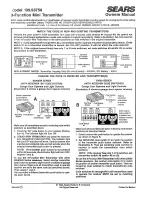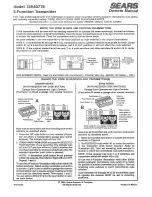
|
26
MN310125 Rev A2
Wiring
(continued)
Step Five
WIRE CONNECTIONS
Red (+) & Black (-):
Red [(+) Power] and Black [(-) Return] leads are for
connection to a 24 VDC power supply or to a 4-20 mA loop power
source. The red and black wires can be extended up to 1,000 feet using
a 22-gauge or larger wire.
White & Green:
White [(W) TX] and Green [(G) RX] leads are reserved
for use with WebCal
®
and also to communicate to PodView
®
. These
wires should only be connected to one device at a time (i.e. only to
WebCal
®
or PodView
®
. In addition, these wires should not be
connected to WebCal
®
while power is supplied from any source other
than the LI99-2001 series Fob. The maximum cable distance between
the computer and EchoPod
®
is 15’.
Note:
Never allow the white or
green wires to touch any power supply.
UG01 and UG03 Series
Blue, Orange, Yellow, Purple & Brown – (UG01 & UG03 Series only):
Blue (RLY1), Orange (RLY2), Yellow
(RLY3) & Purple (RLY4) wires are the relay contacts (normally open) from each of the relays respectively. The
Brown wire (RLY Common) is the common for all the relays. Relay selection is determined by the configuration in
WebCal
®
. Relays are all dry contacts so polarity can be revered from the example shown in the wiring diagram.
EchoPod
®
(UG01 & UG03 series only) uses latching relays. When power is removed to the sensor, the relays will
remain in their last state. Ex: If the relay is energized, when power is removed, the relay will remain in an
energized state.
GENERAL NOTES FOR ELECTRICAL CONNECTIONS, USAGE AND SAFETY
Where personal safety or significant property damage can occur due to a spill, the installation
must have a redundant backup safety system.
Wiring should always be completed by a licensed electrician.
Supply voltage should never exceed 28 VDC.
Do not exceed 28 VDC power on the relays within EchoPod
®
.
Always use stepper relays between the sensor and external loads. For DC circuits use a catch diode
such as 1N4148, shown on the previous page.
Protect the sensor from excessive electrical spikes by isolating the power, whenever possible.
The sensor materials must be chemically compatible with the liquids to be measured.
Design a fail-safe system for possible sensor and/or power failure.
o
During power failure, relays will remain in their current state and will not change until power is
restored and the signal is reacquired.
Never use the sensor in environments classified as hazardous.
















































